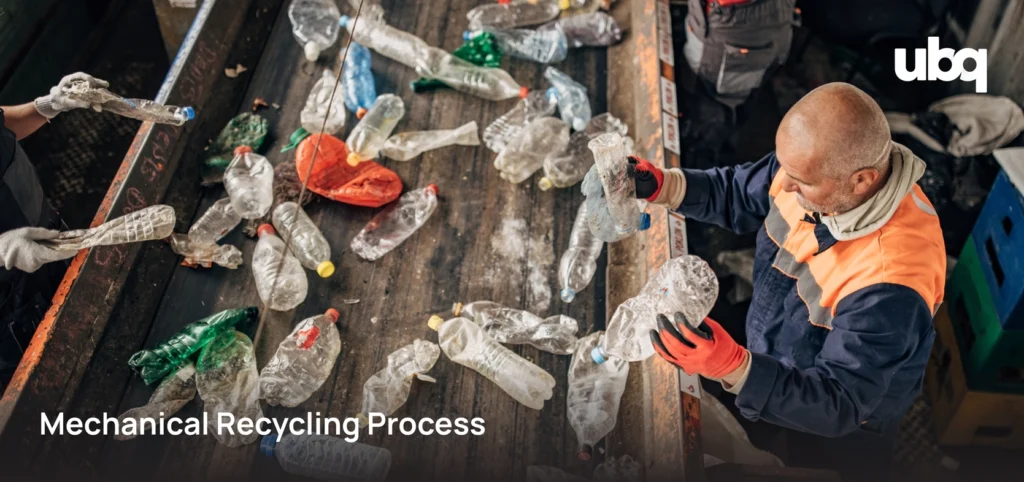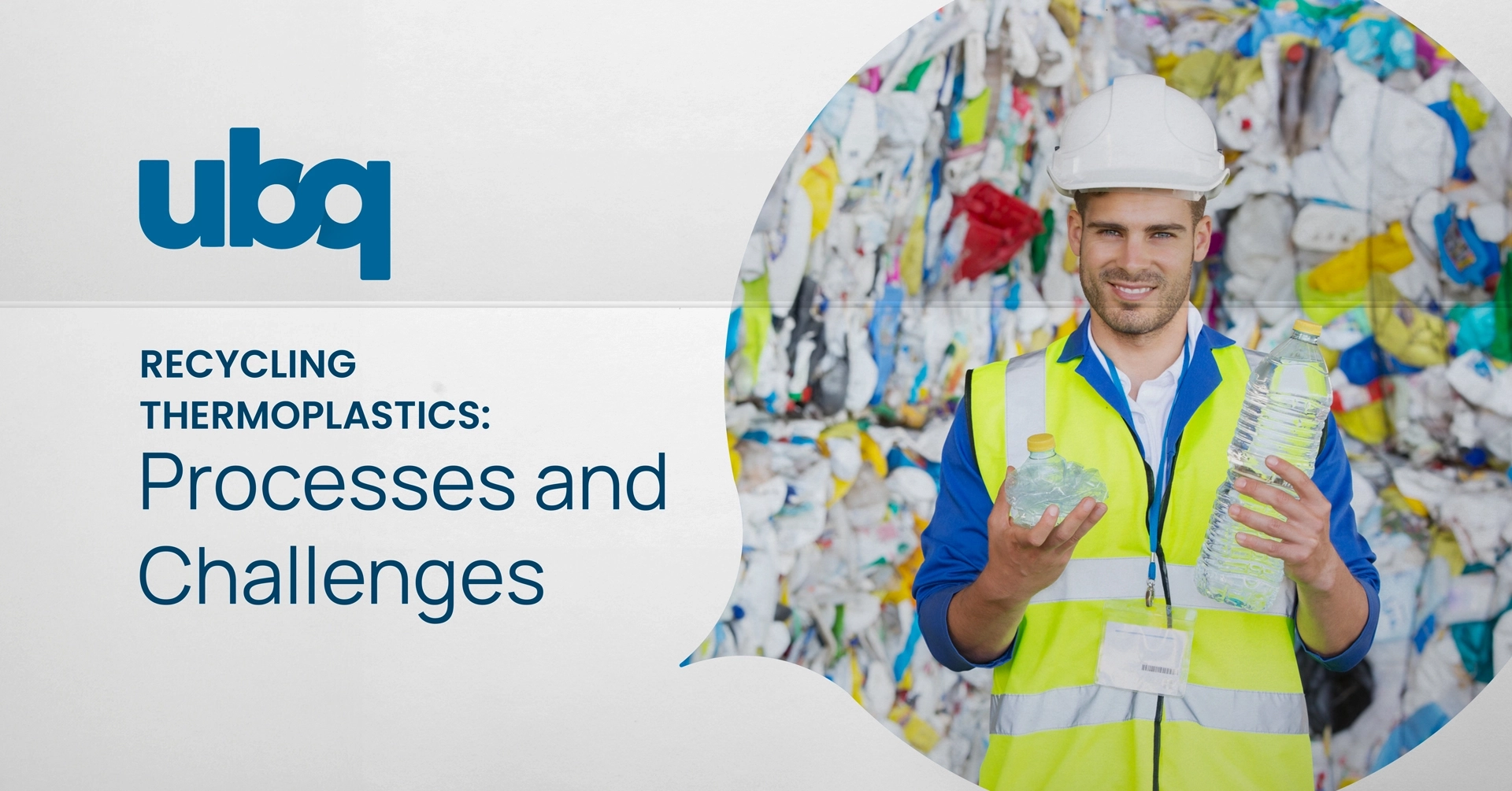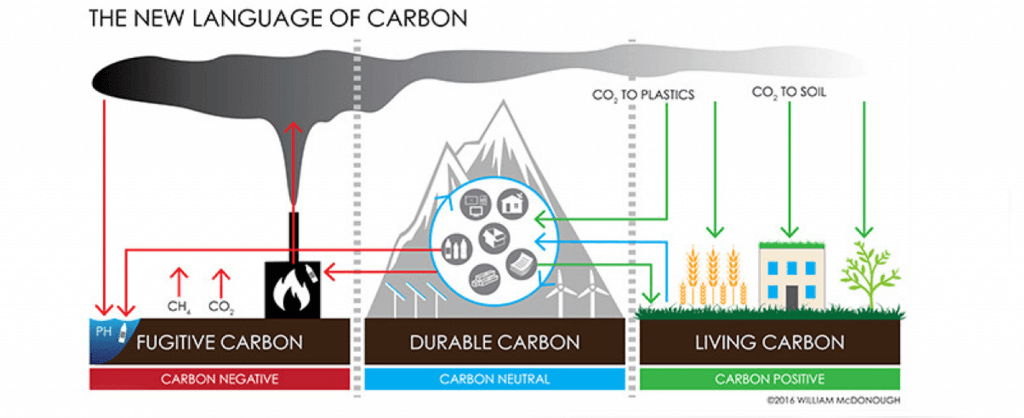Key Takeaways on Recycling Thermoplastics
- Technological innovations are crucial for enhancing the efficiency and effectiveness of thermoplastic recycling.
- Mechanical and chemical recycling processes address different challenges and needs in thermoplastic recycling.
- Economic viability and environmental benefits drive the future growth of the thermoplastics recycling industry.
In an era where sustainability and environmental stewardship have become paramount concerns, the recycling of thermoplastics within the plastics industry emerges as a crucial element in global waste reduction and resource conservation efforts.
Thermoplastics, polymers that exhibit moldability upon heating and solidify upon cooling, are prevalent in numerous applications, ranging from packaging and automotive components to household items and medical devices. However, the substantial quantities and often complex composition of thermoplastic waste generated annually pose challenges to recycling processes.
UBQ Materials, has developed a groundbreaking solution to address the household waste challenges. UBQ converts mixed household waste, including food residues and mixed plastics, into a sustainable thermoplastic material. By transforming waste into reusable resources, UBQ is setting new benchmarks for sustainability within the thermoplastics industry.
What Are Thermoplastics?
Thermoplastics are a category of polymers known for their ability to soften when heated and harden upon cooling, enabling them to be reshaped multiple times without significant chemical alteration. This unique property renders them highly versatile and they are utilized extensively in manufacturing processes. Notable examples of thermoplastics include polyethylene (PE), polypropylene (PP), polyvinyl chloride (PVC), and polyethylene terephthalate (PET).
Types of Thermoplastics
| Thermoplastic | Applications | Properties | Variants/ Benefits/Drawbacks | Source |
|---|---|---|---|---|
| Polyethylene (PE) | Used in plastic bags, bottles, and toys. | Known for its flexibility, durability, and resistance to moisture. | Includes high-density polyethylene (HDPE) and low-density polyethylene (LDPE). | The British Plastics Federation |
| Polypropylene (PP) | Found in packaging, automotive parts, and textiles. | Recognized for its toughness, chemical resistance, and versatility. | Offers a high melting point, making it suitable for various thermal applications. | Polypropylene Europe |
| Polyvinyl Chloride (PVC) | Utilized in pipes, cables, and flooring. | Characterized by its ability to be rigid or flexible depending on formulation, and its resistance to environmental degradation. | Available in rigid (uPVC) and flexible (pPVC) forms. | PVC4Pipes |
| Polyethylene Terephthalate (PET) | Common in beverage bottles and food containers. | Renowned for its strength, thermo-stability, and barrier properties. | Widely recycled due to its value in producing new containers and textiles. | PET Resin Association |
| Polystyrene (PS) | Used for disposable coffee cups, plastic food boxes, plastic cutlery, and packaging foam. | Known for its rigidity, clarity, and insulating properties. | Difficult to recycle due to its bulky nature and contamination risks. | American Chemistry Council |
| Acrylonitrile Butadiene Styrene (ABS) | Found in electronics, automotive parts, and toys. | Valued for its impact resistance, toughness, and ease of machining. | Common in 3D printing and household appliance casings. | Plastics Insight |
How Thermoplastics Are Recycled
Collection and Sorting Methods
Effective recycling of thermoplastics begins with the critical step of efficient collection and sorting of waste materials for recycling. This process involves separating plastics from other waste streams and sorting them by type and color. Advanced technologies, such as near-infrared spectroscopy and automated sorting systems, enhance the accuracy and efficiency of this critical phase. Community recycling programs and curbside collection initiatives are vital, ensuring a continuous supply of recyclable materials and promoting public participation in recycling efforts.

Mechanical Recycling Processes
Mechanical recycling involves the physical processing of thermoplastics into new products. The typical steps include:
- Collection: Waste plastics are collected from municipal, commercial, or industrial sources and brought to a recycling facility.
- Sorting: Plastics are sorted by type, color and thickness or other properties.
- Washing: Removing contaminants such as labels and residues.
- Shredding: Shredding down plastic waste into smaller pieces.
- Second Sorting and Quality Control: Filtering out impurities and mixed materials.
- Drying: Removing moisture from cleaned plastic flakes.
- Melting: Heating the cleaned plastic to form a homogeneous liquid.
- Extrusion Pelletizing: Shaping the melted plastic into pellets.
Mechanical recycling is widely adopted due to its relatively low cost and simplicity. However, it can lead to a degradation of the plastic’s properties after multiple recycling cycles, limiting its use. Also: Contamination Issues, Limited Recyclability, Environmental Impacts (intense energy and water use), Total costs can exceed the cost of virgin resin and most importantly: leakage which means that mechanical recycling cannot close the loop indefinitely;
Chemical Recycling Processes: An Overview of Chemical Recycling
Chemical recycling (often called advanced recycling) is a set of processes that theoretically break down plastic waste at the molecular level, converting it into raw materials that can be used to create new plastics or other chemicals. This method includes various processes such as pyrolysis, depolymerization, and gasification:
- Pyrolysis involves heating plastics in the absence of oxygen to convert them into oil or gas. It works effectively with polyolefins like polyethylene (PE) and polypropylene (PP), but is less suitable for polymers such as PET or PVC. Pyrolysis is often promoted for its ability to recover energy and produce feedstock for new plastics, yet it requires high temperatures and can emit significant greenhouse gases when powered by fossil energy.
- Depolymerization breaks plastics down into their original monomers, which can then be repolymerized into virgin-quality plastics. This method is particularly relevant for PET and polyamides. While promising in terms of closed-loop potential, depolymerization is not universally applicable and often depends on highly sorted feedstock.
- Gasification converts plastic waste into synthesis gas (syngas), a mix of carbon monoxide and hydrogen, which can be used as a chemical building block or energy source. Like pyrolysis, gasification is energy-intensive and may result in air pollutants if not carefully controlled.
- Dissolution uses solvents to selectively dissolve polymers, separating them from additives or contaminants. This allows for the recovery of purified polymers without breaking them down into monomers. While potentially less energy-intensive, dissolution is still an emerging method and often limited by scalability and solvent toxicity.
Chemical recycling offers the advantage of theoretically infinite recyclability without loss of material properties, making it particularly useful for plastics that are difficult to recycle mechanically due to contamination or degradation. However, there are also disadvantages to chemical recycling. These processes generally require more energy and water than mechanical recycling, produce higher greenhouse gas emissions, and can lead to hazardous byproducts. Additionally, some chemical recycling ultimately yields fuel rather than new materials or products—these cases are not considered to be recycling according to many regulatory definitions, as they do not help close the loop on material use. Chemical recycling is very expensive on a limited scale-up opportunity.
Challenges in Thermoplastics Recycling: Addressing Plastic Waste
Contamination and Quality Control
One of the primary challenges in recycling thermoplastics is contamination. Modern thermoplastics often contain over 10,000 additives designed to enhance performance (e.g., flexibility, strength, UV resistance). When plastics are recycled, these additives can persist or break down into toxic compounds, contaminating the recycled content (PCR resin) and reducing its desirability for high-value applications.
Technological Innovations in Recycling
Technological advancements are pivotal in overcoming the challenges associated with thermoplastics recycling, particularly in addressing the environmental impact of plastic waste. UBQ’s patented conversion process, which transforms mixed household waste into a valuable thermoplastic material, exemplifies how innovation can revolutionize recycling practices.
Environmental Impacts of plastic Recycling
Recycling plastic waste significantly reduces the environmental footprint compared to producing new plastics from virgin materials. It conserves resources, reduces greenhouse gas emissions, and minimizes the volume of waste sent to landfills. However, according to the European Environment Agency, only about 9% of the plastics ever produced have been recycled, while 12% have been incinerated. The reason for recycling methods not being effective are due to material complexity, contamination, and economic challenges. In addition, many products are not designed for recyclability.
UBQ™ material offers a breakthrough solution by using mixed household waste, including organics, hard-to-recycle materials, and plastics, as its feedstock. As production and adoption of UBQ™ material grow, it will divert increasing volumes of plastic waste from landfills and incinerators, raising the overall percentage of materials that can be repurposed.
In addition to improving waste recovery, UBQ™’s climate-positive material offers further environmental benefits by converting waste into a valuable resource that reduces greenhouse gas emissions and other environmental indicators, thereby contributing to a more sustainable environment.
Economic Viability of Recycled Thermoplastics
The economic viability of thermoplastics recycling depends on various factors, including market demand for recycled materials. The demand for recycled polymers is unstable and is influenced by the price and perceived quality of recycled versus virgin materials. When oil prices (and thus virgin plastic prices) are high, recycled content becomes more competitive; when virgin materials are cheap, demand for recyclate may drop. Another factor is the cost of recycling processes (the economic case for recycling improves as collection and sorting become more efficient), and regulation and governmental policies. Incentives such as subsidies, tax benefits, and regulations promoting the use of recycled materials can enhance the economic feasibility of recycling initiatives. The integration of innovative recycling technologies also plays a crucial role in reducing costs and improving profitability.
Global commodity price volatility, trade restrictions, and fluctuating demand for recycled content all impact profitability. Diversified revenue streams and long-term contracts help buffer these risks.
Future Trends and Opportunities
The future of thermoplastics recycling appears promising, with trends such as increased use of bioplastics, advancements in recycling technologies, and heightened consumer awareness driving industry growth. Other trends are:
- Mechanical recycling is becoming more efficient with the help of AI-powered sorting, robotics, and improved cleaning systems.
- Brands are responding by committing to recycled content targets and supporting take-back or circular systems.
- Governments are implementing recycled content mandates, plastic taxes, and restrictions on single-use plastics to push industry adoption of sustainable materials.
- Extended Producer Responsibility (EPR) schemes encourage companies to design products that are easier to recycle and invest in recycling infrastructure.
- Future products will increasingly be designed with end-of-life handling in mind.
Companies like UBQ Materials are at the forefront of this transformation, demonstrating that innovative approaches can turn waste management challenges into opportunities for creating sustainable materials. Future advancements are likely to focus on improving recycling efficiencies, developing new materials, and expanding the applications of recycled thermoplastics.
Looking Forward
The recycling of thermoplastics is a complex yet indispensable process in the pursuit of sustainability. By understanding the types of thermoplastics, the recycling processes involved, and the challenges faced, we can better appreciate the significance of this endeavor.
UBQ acts as a powerful complementary solution to traditional recycling methods by addressing the critical limitations and gaps inherent in mechanical and chemical recycling processes.


